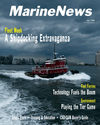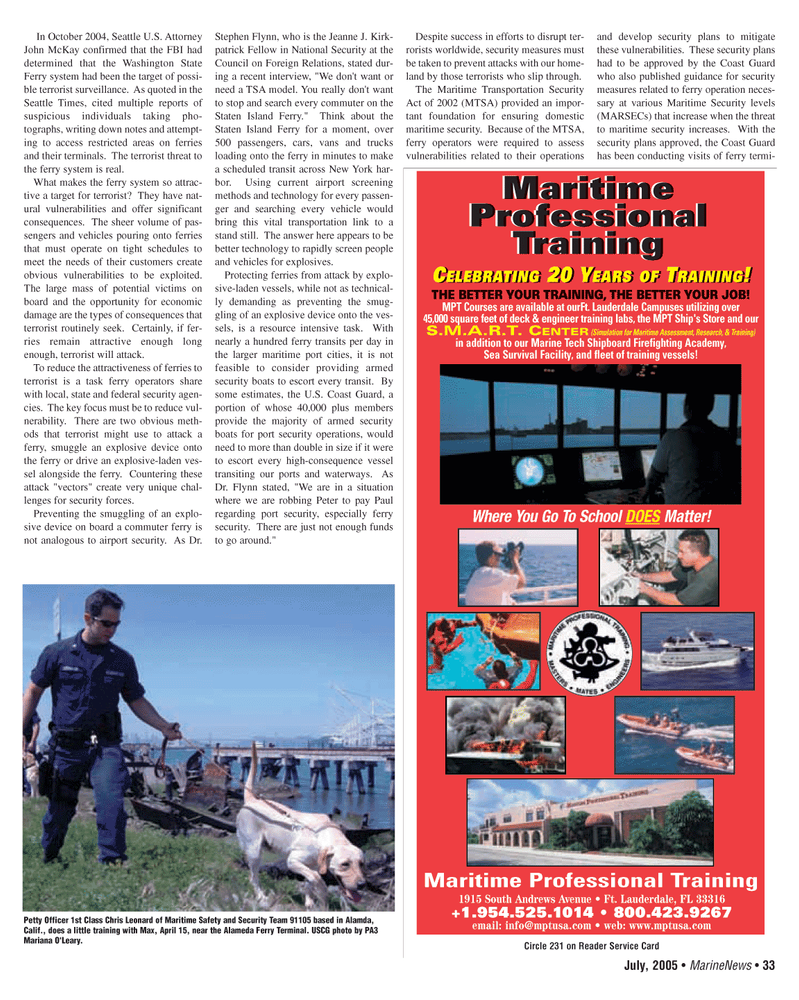
Page 33: of Marine News Magazine (July 2005)
Read this page in Pdf, Flash or Html5 edition of July 2005 Marine News Magazine
In October 2004, Seattle U.S. Attorney
John McKay confirmed that the FBI had determined that the Washington State
Ferry system had been the target of possi- ble terrorist surveillance. As quoted in the
Seattle Times, cited multiple reports of suspicious individuals taking pho- tographs, writing down notes and attempt- ing to access restricted areas on ferries and their terminals. The terrorist threat to the ferry system is real.
What makes the ferry system so attrac- tive a target for terrorist? They have nat- ural vulnerabilities and offer significant consequences. The sheer volume of pas- sengers and vehicles pouring onto ferries that must operate on tight schedules to meet the needs of their customers create obvious vulnerabilities to be exploited.
The large mass of potential victims on board and the opportunity for economic damage are the types of consequences that terrorist routinely seek. Certainly, if fer- ries remain attractive enough long enough, terrorist will attack.
To reduce the attractiveness of ferries to terrorist is a task ferry operators share with local, state and federal security agen- cies. The key focus must be to reduce vul- nerability. There are two obvious meth- ods that terrorist might use to attack a ferry, smuggle an explosive device onto the ferry or drive an explosive-laden ves- sel alongside the ferry. Countering these attack "vectors" create very unique chal- lenges for security forces.
Preventing the smuggling of an explo- sive device on board a commuter ferry is not analogous to airport security. As Dr.
Stephen Flynn, who is the Jeanne J. Kirk- patrick Fellow in National Security at the
Council on Foreign Relations, stated dur- ing a recent interview, "We don't want or need a TSA model. You really don't want to stop and search every commuter on the
Staten Island Ferry." Think about the
Staten Island Ferry for a moment, over 500 passengers, cars, vans and trucks loading onto the ferry in minutes to make a scheduled transit across New York har- bor. Using current airport screening methods and technology for every passen- ger and searching every vehicle would bring this vital transportation link to a stand still. The answer here appears to be better technology to rapidly screen people and vehicles for explosives.
Protecting ferries from attack by explo- sive-laden vessels, while not as technical- ly demanding as preventing the smug- gling of an explosive device onto the ves- sels, is a resource intensive task. With nearly a hundred ferry transits per day in the larger maritime port cities, it is not feasible to consider providing armed security boats to escort every transit. By some estimates, the U.S. Coast Guard, a portion of whose 40,000 plus members provide the majority of armed security boats for port security operations, would need to more than double in size if it were to escort every high-consequence vessel transiting our ports and waterways. As
Dr. Flynn stated, "We are in a situation where we are robbing Peter to pay Paul regarding port security, especially ferry security. There are just not enough funds to go around."
Despite success in efforts to disrupt ter- rorists worldwide, security measures must be taken to prevent attacks with our home- land by those terrorists who slip through.
The Maritime Transportation Security
Act of 2002 (MTSA) provided an impor- tant foundation for ensuring domestic maritime security. Because of the MTSA, ferry operators were required to assess vulnerabilities related to their operations and develop security plans to mitigate these vulnerabilities. These security plans had to be approved by the Coast Guard who also published guidance for security measures related to ferry operation neces- sary at various Maritime Security levels (MARSECs) that increase when the threat to maritime security increases. With the security plans approved, the Coast Guard has been conducting visits of ferry termi-
July, 2005 • MarineNews 33
Maritime
Professional
Training
Maritime Professional Training 1915 South Andrews Avenue • Ft. Lauderdale, FL 33316 +1.954.525.1014 • 800.423.9267 email: [email protected] • web: www.mptusa.com
Where You Go To School DOES Matter!
THE BETTER YOUR TRAINING, THE BETTER YOUR JOB!
MPT Courses are available at ourFt. Lauderdale Campuses utilizing over 45,000 square feet of deck & engineer training labs, the MPT Ship's Store and our
S.M.A.R.T. CENTER (Simulation for Maritime Assessment, Research, & Training) in addition to our Marine Tech Shipboard Firefighting Academy,
Sea Survival Facility, and fleet of training vessels!
CELEBRATING 20 YEARS OF TRAINING!
Circle 231 on Reader Service Card
Petty Officer 1st Class Chris Leonard of Maritime Safety and Security Team 91105 based in Alamda,
Calif., does a little training with Max, April 15, near the Alameda Ferry Terminal. USCG photo by PA3
Mariana O'Leary.
JUNEMN2005 5(33-40).qxd 6/30/2005 3:53 PM Page 33

 32
32

 34
34
